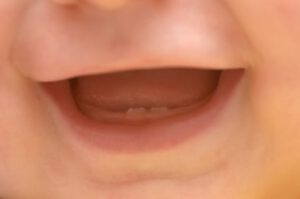
By Bethann Hromatka, Ph.D.
Anyone who’s ever spent time around babies knows that teething can be disruptive and often painful. In that sense, the somewhat violent term “tooth eruption”–referring to the process of teeth breaking through the gums–seems rather appropriate.
Most people experience this phenomenon twice, first when baby teeth come in and again between six and 13 years of age when permanent teeth appear. Some people also have wisdom teeth, which are molars that develop in young adults.
While tooth development can be influenced by environmental factors, genetics also plays a role in both the timing of tooth emergence as well as the number of teeth a person ends up with. Subtle differences in tooth development are very common–for instance roughly 10% of the population is missing some teeth.
A genome-wide association study (GWAS) published in PLoS Genetics this month by researchers in Denmark has now identified genetic factors associated with the emergence of permanent teeth. They analyzed DNA from nearly 9,000 individuals in Denmark and the United States, and found four SNPs that influenced the timing and number of visible teeth at various ages.
For at least three of these SNPs found in this study, the version associated with fewer teeth is relatively common in the population. And although the individual effects of the variants are small – correlated with about half to one tooth fewer, on average – they did seem to add up. In this study, someone with two copies of the “delayed tooth eruption” version at all four SNPs had about six fewer teeth (16 teeth) at 10-12 years of age compared to someone with no copies of the delayed versions (22 teeth).
Interestingly, a study published a few years ago showed that two of these SNPs might also play a role in the eruption of baby teeth.
Some genetic factors contribute to multiple growth-related traits, so the authors tested if the tooth development SNPs were also linked to traits such as age at menarche (first period in young women) and adult height. In general, the genetic factors underlying these traits did not overlap. There was, however, weak evidence suggesting that several of the SNPs associated with permanent tooth development also influence adult height and breast cancer. More research is needed to determine the exact biological mechanisms linking these different traits.
This study represents the first GWAS to look for genetic factors involved in permanent tooth eruption. Studies like this one are interesting because they reveal that there is clearly natural variation across the population–some individuals have more teeth while others have less. These findings also highlight the complex interplay between genetic factors involved in human growth and development.